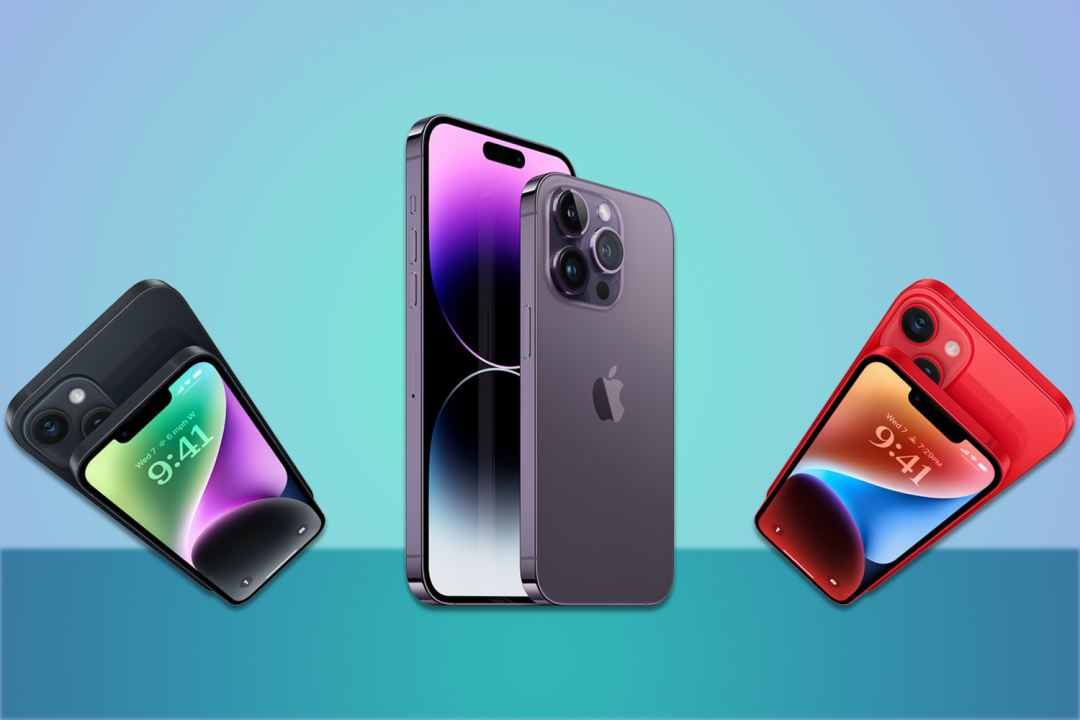Apple iPhone 14 vs 14 Pro vs Plus vs Pro Max: what’s the difference?
Everything you need to know about the iPhone 14 family

With every iPhone release, there are always a few questions. Should I upgrade? What’s the difference between the regular and Pro? Is there still a Mini version? Did aliens really build the pyramids? We can’t answer that last one, but have all the info on Apple’s smartphone range. The iPhone 14 vs 14 Pro debate has cooled slightly now that the latter is formally off sale, and the iPhone 15 range has appeared, but both are still killer handsets.
From differences in their design and screen size, to camera setups and prices, this is your one-stop shop for all things iPhone 14-related. But not aliens. We’ve paid particular attention to iPhone 14 vs 14 Pro, but if you want to compare them to other available iPhones, check out our best iPhone to buy article.
Oh, and if you’re interested in the Apple Watch Series 8, Watch SE, and Watch Ultra comparison, we’ve got you covered in another article too: Apple Watch Series 8 vs Apple Watch SE vs Apple Watch Ultra: what’s the difference?
What are the iPhone 14 models?

Before we dive into the nitty gritty, it’s worth quickly going through how many iPhone 14 models there are.
There were four models at launch — the iPhone 14, iPhone 14 Plus (previously rumoured as the Max), iPhone 14 Pro, and iPhone 14 Pro Max. Observant gadget fans will have noticed that there’s no iPhone 14 Mini. That’s likely because past Mini variants of the iPhone haven’t proved to be as popular as their larger-screened siblings.
Now that the iPhone 15 range has launched, though, only the iPhone 14 and iPhone 14 Plus remain on sale through Apple’s website. If you were hoping to bag an iPhone 14 Pro or iPhone 14 Pro Max, you’ll now need to hunt down stock at other retailers, or try the second hand market.
Apple iPhone 14 pricing

The following US and UK prices were correct on launch day:
| Model | 128GB Price | 256GB Price | 512GB Price | 1TB Price |
|---|---|---|---|---|
| iPhone 14 | $799/£849 | $899/£959 | $1099/£1179 | N/A |
| iPhone 14 Plus | $899/£949 | $999/£1059 | $1199/£1279 | N/A |
| iPhone 14 Pro | $999/£1099 | $1099/£1209 | $1299/£1429 | $1499/£1649 |
| iPhone 14 Pro Max | $1099/£1199 | $1199/£1309 | $1399/£1529 | $1599/£1749 |
As of September 2023, following the launch of the iPhone 15, these are the current prices listed on Apple’s website. They see a healthy price dip across the board:
| Model | 128GB Price | 256GB Price | 512GB Price |
| iPhone 14 | $699/£699 | $799/£799 | $999/£999 |
| iPhone 14 Plus | $799/£799 | $899/£799 | $1099/£799 |
Apple iPhone 14 vs Pro design

Got an iPhone 13 model already? Then the overall design of the iPhone 14 range won’t bring many surprises. Given that they’re still gorgeous slabs of sleek tech though, we’ve got no complaints for sticking to a tried and tested formula, for the time being.
The main rear design differences between the Pro and other models remain too. The Pro and Pro Max have a triple-lens camera setup on the rear, while the 14 and 14 Plus stick with dual lenses.
You’ll also notice a major difference on the front — the Pro Models have Apple’s (ridiculously named) Dynamic Island at the top of the display, which is a fancy way to describe the screen notch that houses the selfie/Face ID cam. It’s a pretty clever design, for reasons we’ll get on to shortly. The iPhone 14 and 14 Plus retain the familiar notch as seen on the previous generation iPhone 13.
In the US, the iPhones also do away with the physical SIM slot, opting for an eSIM solution instead, but the Lighting connector remains. Oh, and there’s a rather fetching purple colour option which will stand out from the crowd, at least, until everyone is walking around with one.
Apple iPhone 14 series: display
The raw screen specs for each iPhone 14 variant can be found below. The important thing to note, beyond the size differences, is the fact that the Pro and Pro Max displays support variable refresh rates up to a slick 120Hz in the form of Apple’s ProMotion display tech. This means that they can raise or lower the refresh rate depending on what you’re doing (e.g. higher refresh rate for gaming, and a lower one for reading). That should help ensure better battery performance, especially if you choose to turn on the Pro models’ Always On Display option to view the time and other widgets when the main screen is locked.
The base iPhone 14 and 14 Plus models are still stuck in the past with 60Hz refresh rates. This is, frankly, a little cheeky, given the plethora of cheaper Android handsets that offer 90-120Hz displays for less.
- iPhone 14: 6.1-inch, OLED, 60Hz refresh rate
- iPhone 14 Plus: 6.7-inch, OLED 60Hz refresh rate
- iPhone 14 Pro: 6.1-inch, OLED, 1-120Hz refresh rate, Always On Display
- iPhone 14 Pro Max: 6.7-inch, OLED, 1-120Hz refresh rate, Always On Display
As mentioned before, the main visual difference between the regular and Pro models, is that the Pro versions ditch the intrusive notch for a sleeker Dynamic Island (aka, a pill-shape cutout). Despite is name, Apple has created some beautifully integrated software features which can expand the Dynamic Island with useful info/controls, such as letting you control music playback or view notifications.
Apple iPhone 14 cameras

The iPhone 14 and 14 Plus feature two main rear cameras, while the 14 Pro and Pro Max have a triple-camera setup.
For the iPhone 14 and 14 Plus, you’re looking at two 12MP rear cameras (a wide and an ultrawide), along with a 12MP TrueDepth selfie cam up front.
The iPhone 14 Pro and Pro Max feature a main, telephoto, and ultrawide, with the 48MP lead lens being the star of the show. It shoots more detail-rich photos, with up to twice the low-light ability of the previous-gen iPhone 13 Pro. Night time photography has actually improved across all three cameras, with 4K/30fps video recording available in Cinematic mode.
Apple iPhone 14 specs, power, and battery life
The iPhone 14 and iPhone 14 Max are powered by the same chipset as the previous generation iPhone 13, which is the A15 Bionic. Despite being a few years old at this point, it remains blazing-fast in most day-to-day apps and games.
Inside the 14 Pro and 14 Pro Max, Apple’s A16 Bionic chip adds even more muscle than the A15, while using less battery power to boot. Some of that extra performance will go towards powering the Dynamic Island’s fancy tricks.
The regular iPhone 14 and Plus have 128GB, 256GB and 512GB storage options, while their Pro siblings bump these all the way up to a cavernous 1TB. And while Apple, as usual, hasn’t revealed specific battery capacity specs, all comfortably manage more than a day of heavy use.
Apple iPhone 14 software
The iPhone 14 family arrived running the then-latest version of Apple’s mobile operating system — iOS 16. Beyond some extra camera features, the experience was largely the same across the board for those coming across from iOS 15.
All four models fully support iOS 17 as an over-the-air update, which is available right now.
Apple iPhone 14 series: which one should you get?

Now that the iPhone 14 Pro and iPhone 14 Pro Max have been removed from sale on the Apple store, your decision over which model to buy is a little more clear cut.
If you’re less fussed about the camera experience and want a slick iPhone while paying less, the base iPhone 14 could serve you very well. It undercuts the iPhone 15 by a decent margin, too. The iPhone 14 Plus remains a good pick if screen size and a bigger battery are priorities.
If you want the very best that Apple has to offer though, it could be worth cracking your wallet open a little wider and looking towards the iPhone 15 generation for the full-fat experience.

